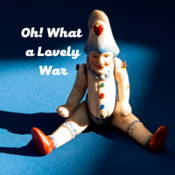
Oh! What a Lovely War was first performed at the Theatre Royal, Stratford East, London on March 19, 1963. The idea for a satirical critique of the First World War emerged out of Joan Littlewood’s Theatre Workshop and it was developed by Littlewood, her partner Greg Raffles, Charles Chilton, and the cast. The title of the musical was inspired by the old music hall song, “Oh It’s a Lovely War�, which features as one of the main songs in the show. It was, and is, therefore a truly collaborative, ensemble production.
The musical combines various different styles of theatre but is ultimately classified as an 'epic musical'. It uses traditional music hall songs from the era, often changing their lyrics, and has a cast of around 12-15 men and women. Traditionally, they are all dressed in pierrot costumes (as commonly seen in commedia dell’arte) as Joan Littlewood hated the idea of khaki uniforms on stage. The pierrot costume also removes individual identities, enforcing the idea of the ensemble, and enabling the cast to play multiple roles with the addition of props or costume pieces. As such, the the action moves on with great speed and there is a lot of improvisation and interaction with the audience. Projected slides are used heavily throughout the musical showing a moving display of First World War statistics and images. Sometimes the slides are in the background, behind the actors, but they are also frequently used on their own for greater impact, with the cast singing offstage.
The first act of the musical draws the audience into the sentimentality of the war propaganda and sense of bonhomie that was prevalent at the beginning of the First World War. It opens at the seaside, where young men and women relax, until the MC announces that it is time for “the war game� to start. As the war begins, the soldiers are trained and march off to fight. The famous Christmas Day meeting between the British and German soldiers in no-man’s land is marked by the songs “Heilige Nacht� and “Christmas Day in the Cookhouse�. As the girls promise the soldiers, “I’ll Make a Man Out of You�, the first act is brought to an abrupt end with the first bomb explosion of the show. The true horror of the First World War is then borne out in Act Two as the projected slides show horrific images of the realities of war for all sides, accompanied by the soldier’s singing “Gassed Last Night�. As General Haig orders further, fruitless offensives, the soldiers sing traditional music hall songs with their lyrics changed to reflect the brutal reality of life in the trenches:
Forward Joe Soap’s Army, marching without fear,
With our old commander, safely in the rear.
He boasts and skites from morn till night,
And thinks he’s very brave,
But the men who really did the job are dead and in their grave
(“Forward Joe Soap’s Army� to the tune of “Onward Christian Soldiers�)
The projected slides reach their conclusion with images of the surviving troops returning home, injured and weary, and frightening statistics of the numbers killed from all nations involved in the war, Against this bleak backdrop, the ensemble sings “Oh It’s a Lovely War�. A stark, satirical take on the realities of the First World War, Oh! What a Lovely War is a theatrical chronicle depicted through the songs and images of the era.
Oh! What a Lovely War guide sections